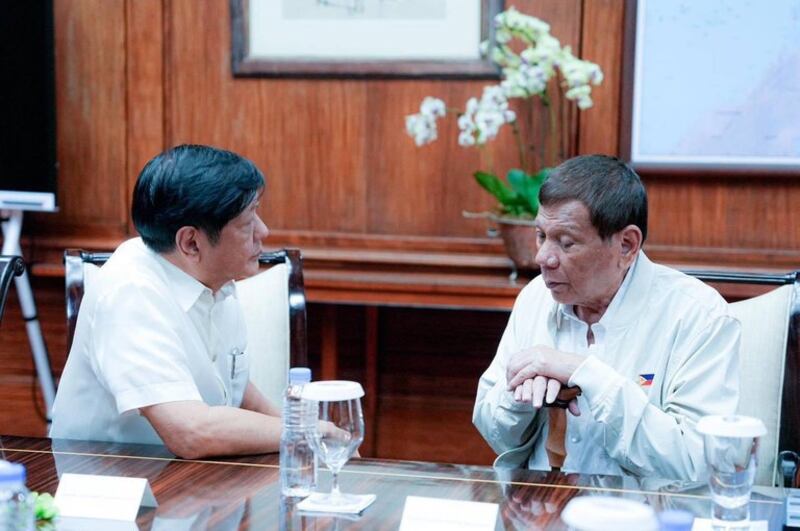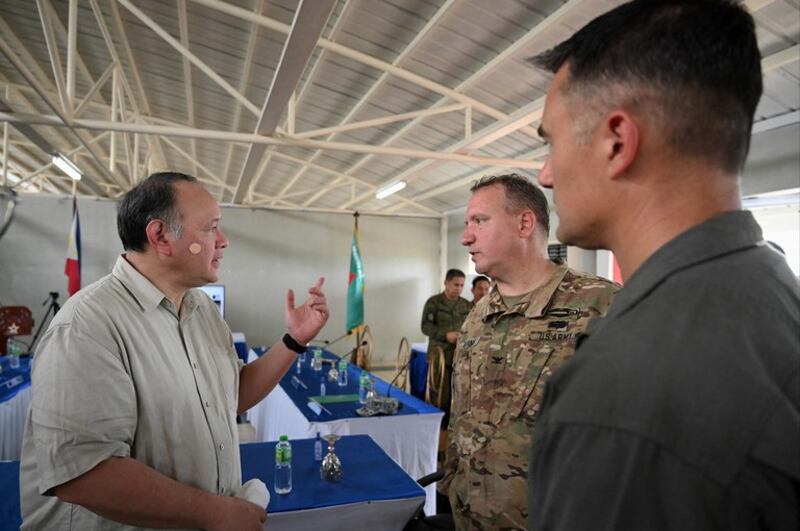Top Philippine defense officials pushed on Thursday for speeding up the construction of upgrades at military bases where U.S. troops will have access amid regional tensions with China.
Defense Secretary Gilberto Teodoro Jr. joined military chief Gen. Romeo Brawner Jr. at the Lal-lo airfield in northern Cagayan province, one of nine bases and facilities covered under a defense pact that the two longtime allies agreed to expand in early 2023.
Tedodor said there was a “need to speed up the development” of the sites “to serve a total national security picture of our country.”
"We need to build more facilities to increase our operational tempo so we have to expedite the development of the five initial EDCA sites and four more Philippine bases with EDCA sites," he told reporters, referring to the Enhanced Defense Cooperation Agreement.

The militaries of both countries are using the airfield here for joint relief operations in the wake of a typhoon that struck the northern Philippines in late July. Teodoro noted "operational limitations" and pointed out that Philippine and U.S. personnel had to use barrels to refuel aircraft by hand.
The five initial EDCA sites approved during previous administrations were: the Antonio Bautista Air Base in Palawan; Basa Air Base in Pampanga; Fort Magsaysay in Nueva Ecija; Lumbia Air Base in Cagayan de Oro City; and Benito Ebuen Air Base in Cebu.
In April, the Ferdinand Marcos Jr. administration announced four additional EDCA sites: Lal-lo airfield; Naval Base Camilo Osias in Sta Ana, Cagayan; Camp Melchor Dela Cruz in Gamu, Isabela; and Balabac island in Palawan.
“The development [at the EDCA sites] is quite slow except for the first five [sites], so we need to work on the four more because they are the most disaster-prone areas actually,” Teodoro said. “And they are also essential to the integrity of our credible deterrent posture and Philippine territorial security.”
Teodoro said the EDCA sites are logistical and the U.S. could use them “to help us speed up the operational tempo and response.”
“But the rest of the Philippine assets that will be positioned in the EDCA sites are Philippine national security items for our territorial defense,” he said.
On Thursday, the U.S. Department of Defense did not immediately respond to a BenarNews request for comment on Teodoro’s statement.
China, Taiwan question
The upgrades are happening amid tensions between the U.S. and China over Taiwan and territorial disputes between the Philippines and China over the South China Sea.
Last month, Teodoro said the government was monitoring on a daily basis for a possible Chinese invasion of Taiwan where 150,000 Filipinos live and work. Their safety could be compromised if China invades the island, which Beijing considers a renegade province.

While officials from Manila and Washington have denied that the flurry of activities at Philippine bases had anything to do with Taiwan, analysts have said that the Southeast Asian country’s strategic location is central to the American aim of deterring a possible Chinese attack on the island.
Some analysts, however, have said it is unlikely that Beijing would carry out its threat of invasion.
Former President Rodrigo Duterte, who met with Chinese leader Xi Jinping in China last month, visited President Marcos on Wednesday, according to the presidential palace in Manila.
Marcos is seen as rekindling Philippine ties with the U.S., as opposed to Duterte who was staunchly anti-American and never visited Washington during his six-year term (2016-22).
“Former President Rodrigo Duterte went to see President Ferdinand R. Marcos Jr. to talk to him about his recent meeting with Chinese President Xi Jinping in China. They also discussed other issues,” Communications Secretary Cheloy Velicaria-Garafil said in a statement.

Duterte gave Marcos “some good pieces of advice,” Garafil said, without elaborating. She said Duterte had met with Xi in his private capacity and was not an official representative of the Philippine government.
The Chinese Foreign Ministry previously said Xi “appreciates the strategic choice Mr. Duterte made to improve relations with China during his presidency.”
On Thursday, Teodoro said the discussion between Marcos and Duterte was “very productive,” but said he was not in a position to divulge details.
Noel Celis and Basilio Sepe in Manila contributed to this report by BenarNews, an RFA-affiliated news service.
